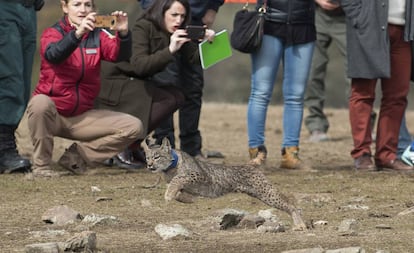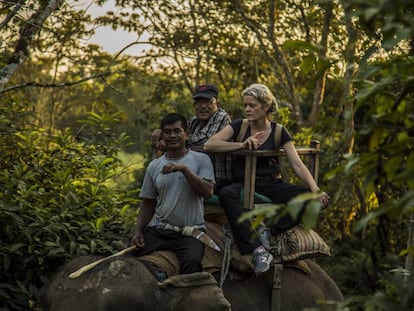The Iberian lynx: No longer a whisker from extinction
At the start of the century there were only 94 examples left in the wild. Fifteen years later, a conservation effort has boosted numbers to 547

Agustín Navarro will never forget the first time he saw an Iberian lynx. “It was sitting there,” he says, pointing to an abandoned construction site that is currently being used for breeding the rabbits that will help these elusive predators to thrive. Navarro was born just five minutes from here in a house on a hillside covered with winter oaks in Vilches, Jaén.
A cattle farmer with a herd of 200, Navarro recently became active in helping this endangered species survive as one of more than 30 beef farmers around the River Guarrizas who have signed agreements allowing the conservationists access to their land. “What did we get in return?” asks fellow farmer Pedro López. “The satisfaction of knowing that you are helping with the survival of the lynx.”
The lynx’s success story is extraordinary if you consider that scientists believe the Earth is in the early stages of its sixth mass extinction
At the turn of this century, the Iberian lynx was a whisker away from disappearing from the face of the Earth. In 2002, there were only 94 of these animals in the wild, prowling the national parks of Doñana and Sierra Morena, both in Andalusia. After 15 years of concerted effort to bring them back from the brink of extinction, numbers reached 547 last year, with new populations in Badajoz, Toledo and Ciudad Real and in the Valle del Guidiana in Portugal. Much of the credit has to go to biologist Miguel Ángel Simón who designed the first conservation program and is still directing the European scheme
Iberlince, in which there are now around 20 active members.

The lynx’s success story is extraordinary if you consider that scientists believe the Earth is in the early stages of its sixth mass extinction. “It’s excellent proof that acts of conservation yield concrete results,” explained Urs Breitenmoser, a feline specialist from the International Union for Conservation of Nature’s Commission of Species Survival, in 2015. That was just prior to the IUCN deciding that the Iberian lynx was no longer critically in danger of extinction. It is now categorized as “in danger.” But if its current trajectory continues, it may be reassessed as simply “vulnerable” by 2025.
The lynx had little variety in its gene pool, so those lynx most likely to increase genetic diversity are chosen
Almost €70 million has been invested in the Iberlince conservation program since 2002, half of which has come from the EU and the other half a combination of funds from local authorities and private members. “We were lucky to get the funds,” says Simón. “Unfortunately, other less attractive species don’t get them.” The Iberlince got one of the biggest grants of all the European conservation programs from the EU’s LIFE program, which finances environmental, nature conservation and climate action projects. The funds have been used to reintroduce the animals into the wild to reinforce existing populations but also to create new populations such as the one around the Guarrizas River.
The first introduction in this area of Jaen took place in 2010. “A study was undertaken to choose the area,” says Maribel García Tardío, who is in charge of the Guarrizas Iberlince program. The key was the proliferation of rabbits, which are the main food source for the lynx. “Rabbit accounts for almost 90% of its diet,” says Simón. “The success of the program is due to the careful selection of the places where they can be reintroduced.”
Diverse gene pools
The last two lynx to be reintroduced to the wild in Guarrizas – known as Olavide and Ofelia – were released last Wednesday in front of a crowd of conservationists, politicians and school children. They are both female and just one year old, the ideal age for release. Olavide and Ofelia were both born into captivity in a breeding center in Silves, Portugal, one of four on the peninsula that have over 200 lynx between them. The reason the conservationists went to the trouble of bringing these two females from Portugal is a matter of genetics. “They are chosen according to their genes,” says vet
Guillermo López. After their numbers were drastically reduced, the lynx had little variety in its gene pool, so those lynx most likely to increase genetic diversity are chosen.
A week before the two females were released into the wild in Jaén, the conservationists from Iberlince put them to sleep to check them out and fit them with collars with radio-trackers to monitor their movements. Around 20% of the lynx in the wild have these collars, which are fundamental if conservationists are to pinpoint locations where the lynx can thrive.
The current EU LIFE program comes to an end this year and Simón is already preparing the next to present to Brussels. One of the main goals now is to consolidate the connection between the different areas where the lynx is surviving and establish connecting routes between populations.
English version by Heather Galloway.
Tu suscripción se está usando en otro dispositivo
¿Quieres añadir otro usuario a tu suscripción?
Si continúas leyendo en este dispositivo, no se podrá leer en el otro.
FlechaTu suscripción se está usando en otro dispositivo y solo puedes acceder a EL PAÍS desde un dispositivo a la vez.
Si quieres compartir tu cuenta, cambia tu suscripción a la modalidad Premium, así podrás añadir otro usuario. Cada uno accederá con su propia cuenta de email, lo que os permitirá personalizar vuestra experiencia en EL PAÍS.
¿Tienes una suscripción de empresa? Accede aquí para contratar más cuentas.
En el caso de no saber quién está usando tu cuenta, te recomendamos cambiar tu contraseña aquí.
Si decides continuar compartiendo tu cuenta, este mensaje se mostrará en tu dispositivo y en el de la otra persona que está usando tu cuenta de forma indefinida, afectando a tu experiencia de lectura. Puedes consultar aquí los términos y condiciones de la suscripción digital.
More information
Últimas noticias
Cubans look to Venezuela fearfully after Trump’s incursion: ‘We could be next’
The operation in Venezuela to capture Maduro threatens to widen the cracks in the MAGA movement
Trump clarifies who is ultimately in charge in Venezuela: ‘Me’
Maduro pleads not guilty before the federal court in New York: ‘I am still the president of Venezuela’
Most viewed
- Alain Aspect, Nobel laureate in physics: ‘Einstein was so smart that he would have had to recognize quantum entanglement’
- Gilles Lipovetsky: ‘If you want to live better and fall in love, take Prozac, don’t look to philosophy’
- Alvin Hellerstein, a 92-year-old judge appointed by Bill Clinton, to preside over Maduro’s trial in New York
- Cuba confirms death of 32 of its citizens in the US attack against Venezuela
- Why oil has been at the center of Venezuela-US conflicts for decades










































